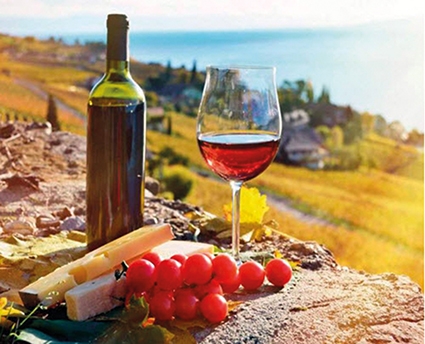Wine Exports in the Spotlight
When speaking about Georgia, it’s almost a certainty that the topic of wine will be raised in the discussion. Over the years, Georgia has become better and better known for the wine it produces. We took at look at the details behind the fame.
Georgia exported 45.4 million bottles of wine to 50 different countries from January to July this year and earned around $107.8 million from doing so. Revenue increased by 28%, while the volume of exports rose by 19%. As for other alcoholic beverages, Georgia exported 9.9 million bottles of Georgian brandy and 219,500 bottles of chacha from January to July this year. In total, Georgia gained $173 million from sales abroad from January to July this year, including wine, brandy, chacha and others. The top countries importing from Georgia, be it wine, brandy, chacha or all three, is as follows: 1st is Russia with 28,564,609 bottles, 2nd is Ukraine with 5,040,319 bottles 3rd is China with 3,514,066 bottles, 4th is Kazakhstan with 1,996,860 bottles and 5th is Poland with 1,886,618 bottles.
According to the American Association of Wine Economists (AAWE); Georgia ranked 5th in the world by wine export price, with $3.49 per liter in 2014-2016. In front of that is France in 1st place with $6.59 per liter of wine, followed by New Zealand at $5.39, the United States at $3.68 and Austria in 4th just ahead of Georgia, with $3.51 per liter of wine. This number will definitely increase for Georgia in the coming months and years, and, as proof of that, on New Year’s Day this year, Georgia and China implemented a free-trade agreement.
In Beijing and Tbilisi, glasses were raised in celebration for a deal that linked the world’s two oldest alcoholic-beverage cultures. Thanks in part to the trade deal, China became Georgian wine’s third-largest global customer. Most of the Georgian wines are inexpensive, a plus for China where wine remains a luxury purchase for most.
“I would say that Chinese consumers are very sensitive to traditions and cultures,” said George Margvelashvili, one if the two men behind wine producer Tbilvino. “They are very proud of having over 3,000 years of written history, just as we are proud of having an uninterrupted culture of wine for thousands of years; however, Georgian wines are not cheap compared to many New World and European competitors.”
Deputy Minister of Environment Protection and Agriculture of Georgia, Giorgi Khanishvili, had a meeting recently with the municipal heads of the Kakheti region regarding the 2018 grape harvest.
The meeting was held in Telavi, and was attended by First Deputy Chairman of the Agrarian Issues Committee of the Parliament of Georgia, Gela Samkharauli, State Representative-Governor of Kakheti, Irakli Kadagishvili, and Acting Chairman of the National Wine Agency, Andro Aslanishvili, along with representatives from information-consulting service firms and local municipalities.
“It is vital for the State to conduct the harvest successfully. In previous years, the harvesting process has required external financial support. As a result of good state policies in the viticulture and winemaking sectors, there is no necessity for this anymore, and business has returned to the right place – the entrepreneur and the farmer agree on prices. Increased exports, diversification of export markets, increased awareness of Georgian wine – these trends are reflected in the economic policy of the country, which provides the basis for a harvest without state subsidies, which is the right business model,” Khanishvili told the meeting’s attendees.
Khanishvili realizes the importance of maintaining international popularity and ultimately increasing export numbers, which Georgia should also realize as a whole. Tourism is a major influence on the Georgian economy; however, wine has the potential to shape the country further economically and agriculturally.
Samkharauli, from Parliament’s Agrarian Issues Committee, pointed out at the meeting that with tourism comes an increased demand for wine consumption on the domestic market. Ultimately, tourism is growing in Georgia and visitors drink wine, so boosting domestic sales; however, once they return from where they came, they speak about Georgian wine, prompting people to either import the wine for themselves or visit the country for the whole experience. As such, he says, it’s a win-win for Georgia and its economy. Georgia needs to take all the wine expertise and skills honed through the ages and point it in the right direction, directions such as their most popular and special wines.
Georgian traditional wine specialties are culturally fascinating and globally unique, however they still have to compete with every other red and white in the world. Rare and intriguing Georgian wines that are being watched closely by wine connoisseurs are Koncho Mtsvivani Kakhuri (white) 2015 Turton Wines, Orgo Rkatsiteli (amber) 2016 Clark Foyster, Orgo Saperavi (red) 2016 Hedonism, Orovela Saperavi (red) 2008 Waitrose, Tbilvino Qvevris (amber) Marks and Spence, Tbilvino Qvevris Saperavi (red) 2015 Georgian Wine Society, Tbilvino Tsinandali (white) 2015 Georgian Wine Society and Vita Vinea Kisi (amber) 2016 Clark Foyster.
Some current leading Georgian wine producers who are also being watched closely are Avtandil Bedenashvili, Casreli, Dakishvili Family Vineyards, Dugladze, Duruji Valley, GWS, Khareba, Koncho & Co, Chateau Lipartiani, Manaveli, Mosmieri, Chateau Mukhrani, Orgo, Schuchmann, Shumi Estate, Tbilvino, Tsinandali, Vinoterra, and Vita Vinea.
By Shawn Wayne











